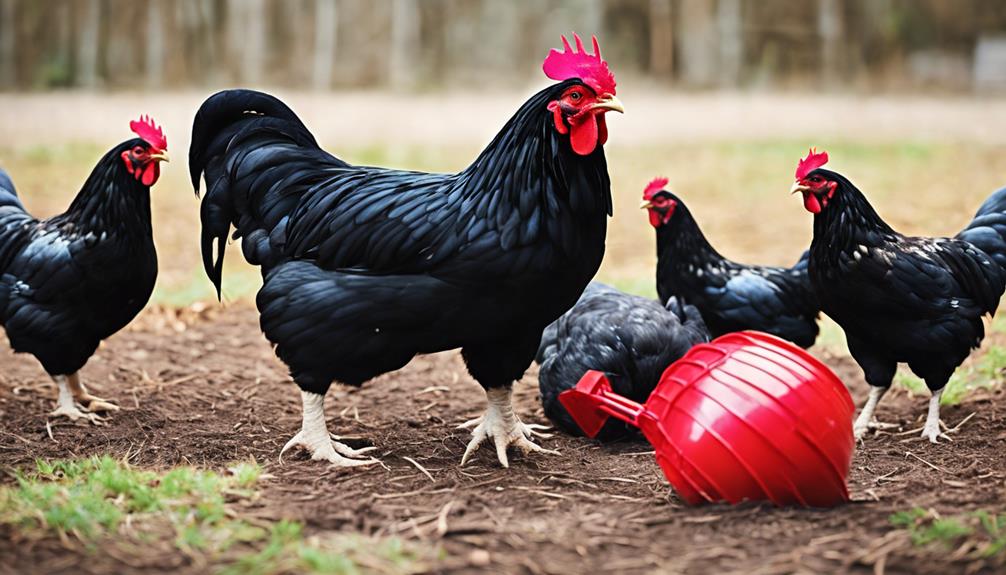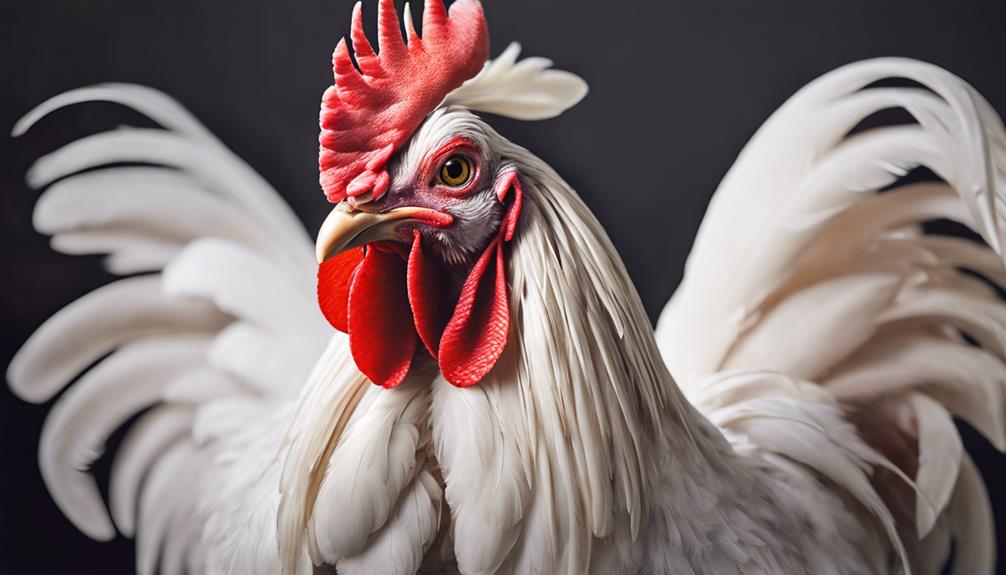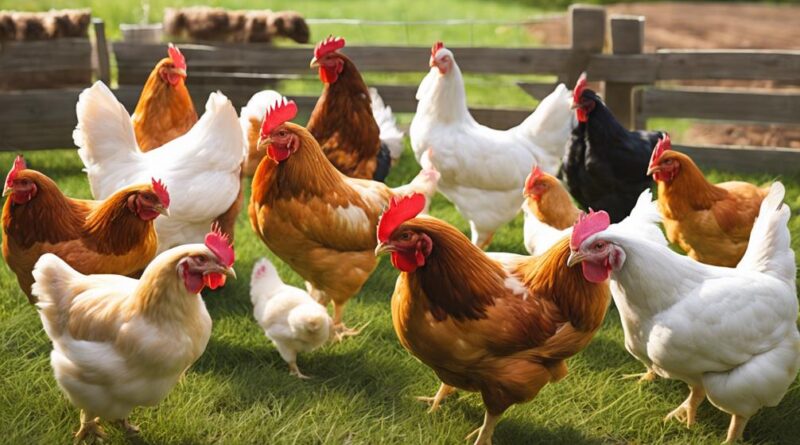Top 10 Breeds for Optimal Chicken Reproduction Success"
For optimal chicken reproduction success, consider breeds like Rhode Island Red for robust genetics and 300 eggs yearly. Plymouth Rock exhibits broody behavior and strong shells. Sussex are friendly with 250-280 eggs annually. Leghorn breeds are exceptional layers with 280-320 white eggs. Orpingtons have breeding techniques and produce 175-200 brown eggs. Australorps lay 250-300 eggs, thrive in various climates, and have a gentle temperament. Marans lay dark brown eggs and are globally popular. Brahmas need good health and nutrition for 150-200 large eggs. Silkies have good genetics, lay 100-120 eggs, and are excellent mothers. Discover more about these breeds for top chicken reproduction success.
Rhode Island Red
When selecting a breed for optimal reproduction success, the Rhode Island Red stands out for its robust genetic heritage and proven track record in egg production. Rhode Island Red hens are renowned for their exceptional egg-laying abilities, consistently producing large brown eggs. This breed is a favorite among poultry farmers and backyard enthusiasts alike due to its impressive laying performance, with hens laying up to 300 eggs per year.
In addition to their outstanding egg production, Rhode Island Reds also exhibit desirable temperament characteristics. Known for their friendly and docile nature, these chickens are easy to handle and make great additions to any flock. Their calm demeanor makes them a popular choice for those new to raising chickens, as they aren't only productive but also pleasant to interact with.
Furthermore, Rhode Island Reds are hardy birds that adapt well to various climates, making them an excellent choice for both experienced and novice chicken keepers. Their ability to thrive in different environments, coupled with their reliable egg-laying capabilities and amiable temperament, solidifies the Rhode Island Red's status as a top breed for optimal reproduction success. Whether you're looking to boost your egg production or simply enjoy the company of friendly chickens, the Rhode Island Red is a breed that delivers on both fronts.
Plymouth Rock
With a rich history deeply rooted in American agriculture, the Plymouth Rock breed of chickens showcases a remarkable combination of versatility and productivity. Plymouth Rocks are known for their broody behavior, which means they've a tendency to sit on their eggs to hatch them. This characteristic can be beneficial for reproduction success, as the broody behavior increases the chances of successful incubation and hatching of chicks.
One of the appealing features of Plymouth Rock chickens is the variety of egg color variations they produce. These chickens lay large brown eggs, adding a visually pleasing aspect to your egg basket. The consistent production of eggs with strong shells and rich yolks makes Plymouth Rocks a popular choice for those looking to maximize their egg yield.
When it comes to reproduction, the broody behavior of Plymouth Rock hens plays a significant role. By exhibiting this natural instinct to care for their eggs, Plymouth Rocks contribute to the continuation of their breed through successful incubation. Their reliability in consistently laying eggs of various colors also adds to their overall reproductive success.
Sussex
The Sussex chicken breed demonstrates a remarkable balance of adaptability and reproductive efficiency in poultry farming. Originating from Sussex, England, this breed has gained popularity for its dual-purpose capabilities, excelling in both egg production and meat quality.
Here are some key points to consider when looking at the Sussex breed:
Sussex Breed Characteristics:
- Sussex chickens are known for their friendly and docile temperament, making them easy to handle and suitable for backyard farming.
- They come in a variety of colors, including Light, Red, Speckled, and Buff, adding aesthetic appeal to any flock.
- Sussex hens are good layers, exhibiting consistent egg production throughout the year.
- This breed is hardy and able to adapt well to various climates, thriving in both free-range and confined environments.
Sussex Breed Egg Production:
- Sussex hens are reliable layers of large, brown eggs, averaging around 250-280 eggs per year.
- Their eggs are known for their rich flavor and quality, making them a favorite among many poultry enthusiasts.
- Sussex chickens reach maturity relatively early, typically starting to lay eggs around 5-6 months of age.
- Proper nutrition and care can further enhance their egg-laying potential, ensuring a steady supply of fresh eggs for your household.
When considering a breed that offers a harmonious blend of adaptability, productivity, and quality, the Sussex chicken undoubtedly stands out as an excellent choice for optimal reproduction success.
Leghorn
Originating from Italy, Leghorn chickens are recognized for their exceptional egg-laying abilities and distinctive appearance in the poultry industry. When it comes to leghorn egg production, these chickens are among the best performers, laying an average of 280–320 large white eggs annually. This high rate of egg production makes Leghorns a popular choice for commercial egg farms and backyard chicken enthusiasts alike.
In terms of leghorn temperament traits, these chickens are known for being active, alert, and sometimes skittish. Leghorns are independent birds that prefer to roam and forage freely. They aren't particularly affectionate towards humans, but they can be friendly if handled gently and regularly from a young age. Their lively and curious nature can sometimes lead them to be flighty or easily startled, so providing adequate space and enrichment in their environment is essential to keep them happy and stress-free.
Orpington
Orpington chickens, known for their gentle demeanor and dual-purpose qualities, are a popular choice among poultry enthusiasts for their robust characteristics and productivity. If you're considering Orpingtons for your flock, here are some key points to keep in mind:
- Breeding Techniques:
When it comes to breeding Orpington chickens, it's essential to select breeding stock with desirable traits such as good egg production, strong health, and adherence to breed standards. To maintain genetic diversity, avoid inbreeding and periodically introduce new bloodlines. Additionally, providing a stress-free environment, balanced nutrition, and proper healthcare is crucial for successful breeding.
- Egg Production Rates:
Orpingtons are known for their moderate egg-laying capabilities. On average, a healthy Orpington hen can produce around 175-200 brown eggs per year. To boost egg production, ensure your hens have a well-balanced diet rich in calcium and protein, access to clean water at all times, and a comfortable nesting area. Regular collection of eggs also encourages hens to continue laying consistently.
- Temperament and Handling:
Orpingtons are prized for their calm and friendly nature, making them great additions to backyard flocks, especially for families with children. When handling Orpingtons, approach them gently to build trust and minimize stress, which can positively impact their reproductive health.
- Broodiness:
Orpingtons have a tendency to go broody, meaning they may actively seek to sit on and hatch eggs. While broodiness can be beneficial if you want to hatch chicks naturally, it can reduce egg production. If you're not looking to hatch eggs, consider strategies to discourage broodiness, such as removing eggs promptly and providing a less conducive nesting environment.
Wyandotte
Why are Wyandotte chickens favored by many poultry enthusiasts for their unique characteristics and versatility in breeding programs?
Wyandottes are a popular choice due to their broody behavior and variety of egg colors. Their broodiness, a trait where hens exhibit a strong desire to sit on their eggs to hatch them, makes them excellent natural mothers. This behavior can be advantageous for breeding programs as it eliminates the need for artificial incubation methods.
In terms of egg color varieties, Wyandottes offer a range of options, including brown, blue, green, and even dark chocolate-colored eggs. This diversity in egg colors can add visual interest to your flock and is appealing to those interested in collecting a colorful assortment of eggs.
Wyandottes are also known for their dual-purpose nature, excelling in both egg production and meat quality. This makes them a practical choice for breeders looking to maintain a sustainable flock that serves multiple purposes. Additionally, their calm temperament and cold-hardy characteristics make them well-suited for various climates and environments.
Australorp

Australorps have gained recognition in the poultry community for their exceptional egg-laying capabilities and robust constitution. If you're looking to maximize egg production and ensure a healthy flock, Australorps might be the breed for you. Here's why:
- Egg Production: Australorps are known for their impressive egg-laying abilities, consistently producing large brown eggs. On average, they can lay up to 250-300 eggs per year, making them one of the most prolific layers among chicken breeds.
- Hardiness: These birds are hardy and adaptable, able to thrive in various climates. Their robust constitution makes them less prone to diseases, which is essential for maintaining a productive flock.
- Gentle Temperament: Australorps are known for their friendly and docile nature, making them easy to handle. Their calm demeanor also makes them less likely to exhibit aggressive behavior towards other flock members.
- Broodiness Behavior: While Australorps can occasionally go broody, their broodiness behavior isn't as pronounced as some other breeds. This means they're less likely to stop laying eggs altogether when they go broody, ensuring a more consistent egg production throughout the year.
Marans
Known for their distinctive dark eggs and excellent meat quality, Marans chickens are a popular choice among poultry enthusiasts seeking both aesthetic appeal and culinary satisfaction. Originating from France, Marans have gained popularity not only for their delicious meat but also for their unique egg coloration genetics. The dark brown eggs of Marans are a result of a genetic trait that dates back to their breeding history in the French town of Marans.
French breed popularity has contributed significantly to the success of Marans chickens globally. The breed's reputation for producing eggs with rich, chocolate-colored shells has made them highly sought after in the poultry world. This popularity has led to an increased interest in understanding the genetics behind their egg coloration, with breeders and researchers delving into the intricacies of Marans' genetic makeup to enhance and preserve this coveted trait.
When it comes to egg coloration genetics, Marans exhibit a range of shades from deep chocolate to lighter browns. This variation is due to different genetic factors influencing the production of pigments in the shell glands of the hens. Through selective breeding practices, breeders can work towards maintaining and improving the consistency of egg coloration within the Marans breed, ensuring that future generations continue to delight with their beautiful dark eggs.
Brahma

Originating from the United States in the mid-19th century, Brahma chickens are revered for their large size and gentle temperament in poultry farming. If you're considering Brahma chickens for reproduction success, here are some key points to keep in mind:
- Brahma Breeding Techniques:
- Brahma chickens are known for their slow maturation rate, so it's essential to select breeding stock with good health and vigor to ensure successful reproduction.
- When breeding Brahmas, pay attention to their size and weight to avoid potential difficulties during mating or egg laying.
- Brahma Egg Production Statistics:
- Brahmas aren't the most prolific egg layers compared to other breeds, producing around 150 to 200 eggs per year.
- While they may not lay as frequently as some breeds, Brahma eggs are notably large and nutritious, making them a desirable choice for many poultry keepers.
- Nutrition and Care:
- Providing a balanced diet rich in protein and calcium is crucial for optimal egg production in Brahma chickens.
- Ensuring a stress-free environment and adequate access to water can also positively impact their reproductive performance.
Silkie
Silkies, a unique breed of chicken known for their fluffy feathers and friendly demeanor, are popular among poultry enthusiasts for their distinctive appearance and broodiness. When it comes to Silkie breeding techniques, it's crucial to consider genetic diversity in silkies to maintain healthy and robust offspring. Breeders should aim to introduce new genetic lines periodically to prevent inbreeding and promote overall genetic health within the Silkie population.
In terms of Silkie egg production, these chickens aren't the most prolific layers compared to other breeds. They typically lay around 100-120 small cream-colored eggs annually. However, their broodiness and excellent mothering instincts make them valuable for hatching eggs from other breeds or even for fostering chicks.
To ensure the health and nutrition of silkies, a well-balanced diet is essential. Silkies are prone to obesity, so it's crucial to provide them with a diet that's high in protein but low in fat. Additionally, proper housing and regular health check-ups are vital to prevent common issues such as feather mites or respiratory infections in silkies. By paying attention to these aspects of care, breeders can maintain the well-being and reproductive success of their Silkies.
Frequently Asked Questions
Do These Breeds Require Special Nesting Conditions?
When considering special nesting conditions for optimal breed reproduction success, it's crucial to understand the requirements of each breed. Some breeds may need specific nesting setups to feel secure and comfortable laying eggs, contributing to successful reproduction. Factors like nest box size, privacy, and cleanliness are essential for creating the ideal environment.
Researching the preferred nesting conditions for your chosen breed can significantly impact their reproductive success and overall well-being.
Which Breed Is Best for Free-Range Settings?
For free-range settings, you'll want a breed that excels at foraging and thrives in various environments. Some chickens are superior foragers and adapt well to different conditions, making them ideal for this setup.
These breeds can roam and find their own food, reducing your input costs. When selecting a breed, prioritize those known for being the best foragers and capable of adapting to their surroundings for optimal success in a free-range environment.
What Is the Average Lifespan of These Breeds?
When considering the average lifespan of chicken breeds and their breeding habits, it's important to note that each breed varies. Factors like genetics, diet, and environment play a significant role in determining lifespan.
Some breeds, like the Rhode Island Red, may live 5-8 years, while others, like the Leghorn, tend to have a shorter lifespan of around 4-6 years. Understanding these variations can help you make informed decisions about breed selection for optimal reproduction success.
Can These Breeds Be Raised in Urban Environments?
In an urban setting, raising chickens involves navigating urban coop design regulations and community rules. Consider noise levels and space requirements when choosing breeds suitable for urban environments.
Ensure your coop design meets local regulations and noise restrictions. Select breeds known for being quieter and needing less space, such as bantam breeds.
Research the specific regulations in your area to ensure you can successfully raise chickens in an urban setting.
How Do These Breeds Compare in Terms of Broodiness?
When comparing breeds in terms of broodiness, you'll notice variations in egg production rates. Some breeds are known for being highly broody, which can affect their egg-laying frequency.
On the other hand, breeds that are less broody tend to lay eggs more consistently. Understanding these differences can help you choose the right breed based on your priorities, whether you value broodiness or egg production rates.
Conclusion
In conclusion, selecting the right breed of chicken can significantly impact the success of your flock's reproduction. By choosing breeds such as Rhode Island Red, Plymouth Rock, or Sussex, you can increase egg production and overall reproductive health.
Consider factors like size, temperament, and egg color when making your decision. With careful research and planning, you can ensure optimal reproduction success in your poultry flock.
Choose wisely and watch your chickens thrive.
